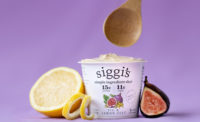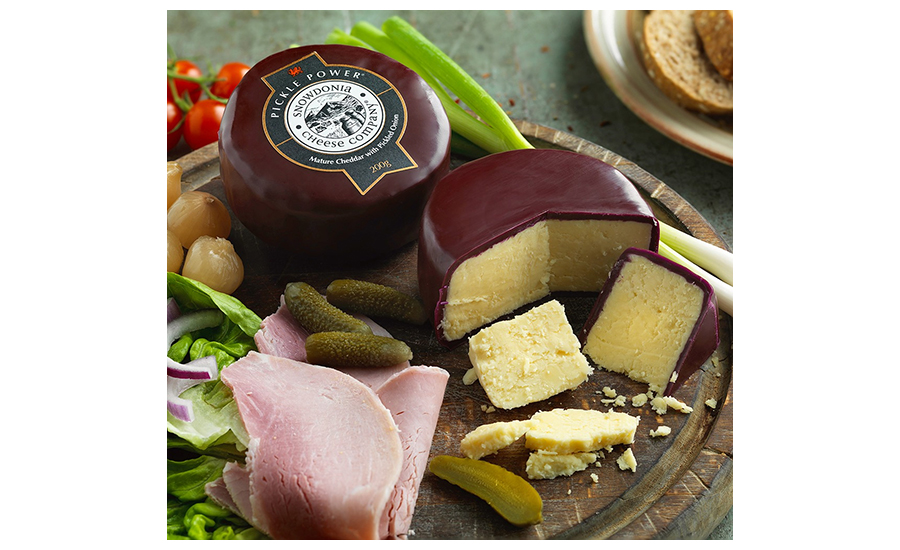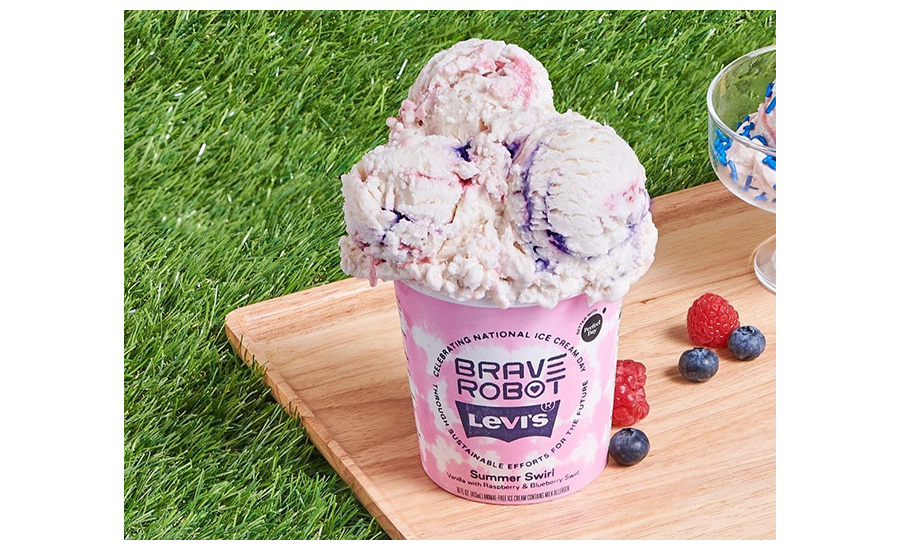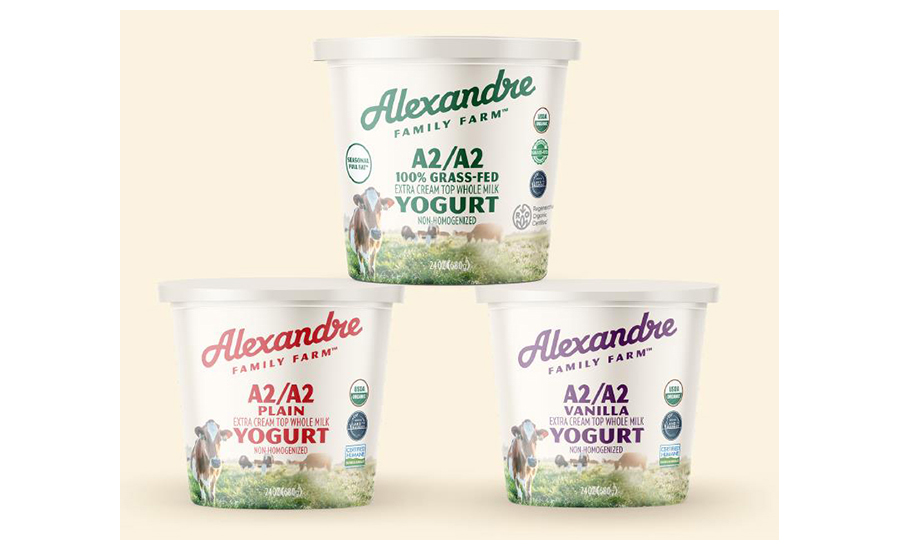STATE OF THE INDUSTRY: 2022
Dairy Products are Booming Thanks to Health- and Comfort-Conscious Consumers
Huge growth in plant-based dairy analogs, and flat liquid milk sales certainly cannot be denied, but according to research by multiple organizations, dairy foods are enjoying a steady growth

Dairy makers are getting more creative as they expand flavor offerings of traditional dairy favorites.
PHOTO COURTESY OF: Snowdonia Cheese Co.

One of the biggest advances in dairy technology is the perfected craft of creating real dairy proteins via microbial fermentation, leaving the cow out of the production equation.
PHOTO COURTESY OF: Urgent Co./Brave Robot

With annual yogurt sales heading pass the $100 billion mark, yogurt makers are outdoing each other to elevate the health, flavor, and eco-consciousness of their offerings.
PHOTO COURTESY OF: Alexandre Family Farm

Flavor still rules, and trending flavors in dairy are focusing on produce, especially fruit and vegetable combinations.
PHOTO COURTESY OF: Urgent Co./Modern Kitchen

Better digestibility, higher nutrient levels, and creamier textures are targets for today’s liquid dairy products.
PHOTO COURTESY OF: Chobani, Inc.





For several years, reports of a decline in consumption of dairy milk has led some to erroneously believe the dairy industry is slowing down, or even moribund. Huge growth in plant-based dairy analogs, and flat liquid milk sales certainly cannot be denied, but according to research by multiple organizations, dairy foods are enjoying a steady growth. A new report from Innova Market Insights revealed global sales for yogurt (both dairy and alternative) is on target to pass the $100 billion mark this year.
Cheese, too, while always popular, saw Allied Market research reporting growth of the US cheese market coming in at a CAGR of 5.25% through to 2027, expected to hit $45.5 billion by 2027. With Statista predicting the global cheese market to hit near $110 billion in the same period, that indicates Americans will be enjoying nearly half of the cheese on the planet.
And no way are we leaving out ice cream. The International Dairy Foods Association (IDFA) noticed last year that ice cream production in 2021 was on track to beat a five-year high set the year before of well more than a billion gallons produced. The report noted that spring 2021 sales of frozen novelties like chocolate ice pops and ice cream bars were already running 24% ahead of the 2019 figures for the same period. Meanwhile, a Fortune Business Insights analysis predicted global ice cream sales will near $92 billion in 2027, a 30% jump from $71 billion in 2019.
Drivers of this pro-dairy trend include the recent impact of the global health crisis and its twin-pronged stimulation of consumer interest in both health and comfort foods. Consumers recognize dairy as a rich source of highly bioavailable protein, vitamins, and minerals. They also equate cultured dairy and i6ts probiotic benefits as important to digestive health, and therefore immunity.
Dairy manufacturers are continuing efforts to better serve these consumer desires. On the health front, products catering not only to human health but ecological health—sustainability, organics, and even packaging being key points concerning the latter.
Kid-focused
Dairy products made for younger consumers tend to hit both the health and the comfort targets. Dairy products are the second largest category of new products for children aged five to twelve. Top sellers are milk mixed beverages and drinkable yogurt, with spoonable yogurt, liquid milk, processed cheese items, and ice cream and other desserts following. But flavor is king for this category.
While chocolate, vanilla, and strawberry are favorites, coming up fast are banana, coconut, and caramel. Most new dairy products for children are sugar- and fat-reduced, plus bolstered with fiber and extra vitamins and minerals. Ingredient makers have developed new natural stabilizing systems to increase shelf life and avoid separation and sedimentation in even the most difficult cases, even with cocoa, where it keeps the particles suspended.
These ingredients are especially handy with the growing popularity of milk-juice combination beverages, as well as for yogurt and yogurt drinks. Puddings and ice cream, too, are getting boosted with the same with health benefits.
New flavors and formats are in the milk and cream cases as well. Clover Sonoma Farms, a certified B-corporation, expanded its organic, ultra-pasteurized Clover the Rainbow line of milk for kids with a lactose-free offering and one boosted with DHA omega-3 and choline. All the company’s milks are sourced from American Humane Certified, Northern California family farms.
Meanwhile, Chobani, Inc. is continuing its foray into the digestibility space with two new dairy platforms: Chobani Ultra-Filtered Milk—a lactose-free, high-protein (2.5 times more protein than traditional milk) ultrafiltered milk, and Chobani Half & Half. The company uses a special filtration process to render the milk lactose-free, with half the sugar and 2.5 times more protein than traditional milk.
Sustainability meets digestibility
The health crisis of the past couple of years only served to increase consumer awareness of maintaining a healthy environment and transparent sourcing of what we eat. In practically every survey of consumer attitudes conducted since 2020, sustainability and other “social ingredients” have proven to be nearly as important as the physical ingredients that go into foods and beverages.
Case in point, a 2020 study by Lightspeed/Mintel revealed that specifically for yogurt, climate concerns were impacting purchase behavior. This was most prominent among those younger adults aged 18-34. Where 16% of all yogurt buyers signaled that environmentally friendly practices are an important purchase attribute, 26% of the younger contingent held that criterion.
Alexandre Family Farm, the country’s first and only certified regenerative organic dairy farm, responded to this demand with its 100% grass-fed A2/A2 organic yogurt, the first of its kind. The company’s yogurt, available in plain and vanilla flavors, is the first yogurt certified as being based on regenerative agriculture. It also is the first yogurt to follow seasonal milkfat. That is, the company’s yogurts do not have a standardized level of milk fat. Rather, for each batch, the milkfat percentage is the same as it was from the cow on the day of milking.
Dairy makers will continue to keep their fingers on the pulse of consumer needs and trends, while exploring new flavors and combinations that enhance healthier dairy offerings. While the plant-based dairy analogs might seem like a challenge, it is evident that they are inspiring dairy makers to grow in creativity and expand their collaboration with consumers in the process.
New Dairy Tech is Brewing
The biggest leap forward for dairy has been the development of microbial-derived milk proteins crafted through fermentation. Although some companies have spent more than a decade developing the technology, “animal-free” dairy only recently became a reality.
Several food-tech companies have been creating milk proteins that are structurally and functionally the same as casein, whey, and other proteins derived from cows, but leaving Bossie in the field. With much of the technology advancement coming out of Israel, scale-up has proceeded apace and a number of products already have been commercialized allowing manufacturers to create sustainable milk, creamers, frozen desserts, and other dairy products with the same organoleptic and nutritional qualities of their animal-derived counterparts.
One of the methods used for the fermentation of dairy proteins involves taking microbes typical to those found in a cow and culturing them in a “soup” of plant-derived sugars. This method is less time-intensive and allows for a less expensive extraction step than isolating proteins from animal or plant sources. Not only is it more affordable source of dairy proteins, it’s more sustainable, producing a creamy, white, neutral-flavored protein with a complete profile of all the essential amino acids, and in proportions equivalent to standard whey and casein isolates.
Product makers have been using these protein powders in sports beverages, cheeses, frozen desserts, creamers, and spreads. Examples that recently hit the shelves include Urgent Co. subsidiary Brave Robot Co.’s animal-free ice cream. The company uses a fermentation crafted “non-animal whey protein that is molecularly identical to whey from cow’s milk.” The company notes, “this process means using less land, less water, and less greenhouse gas emissions to create animal-free dairy ice cream that is not like dairy, it is dairy — just without the cows.”
Such foods can be marketed to flexitarians, vegans, and consumers seeking clean-label, eco-friendly, animal-free alternatives to dairy favorites that require no compromise. Some fermented dairy ingredient makers can offer product high in B vitamins, including cobalamin and riboflavin, as well as in iron. Functionality studies also have demonstrated the protein’s capacity to act as stabilizers in other formulations.
Producing flavor
The healthy dairy trend has experienced a burst of interesting flavor combinations involving produce. Fruit and vegetable enhanced yogurt offerings such as cucumber, watermelon and lime and jalapeño blackberry, and even carrot, beet, and tomato yogurts provide enticing twists in the category. The move to bring a greater variety of produce into dairy extends to cottage cheese as well, with items such as Kraft Heinz Company, LLC’s Breakstone’s Dairy line and its mango-Habanero. HP Hood, LLC brought out a cucumber cottage cheese spiked with dill and just gave limited release to an “Everything Bagel” seasoning cottage cheese offering. Other companies have tried out combos such as cherry-beet, spiced apricot and butternut squash, zucchini with lemon, spinach and pineapple with kiwi, and blueberry-cucumber.
Enzyme Tech
While enzymes have been used in dairy manufacturing forever—think rennet in cheese making—some new developments in enzymes are improving the function and nutrition of products such as milk powders. Enzymatically hydrolyzed lecithin, for example, is being employed to optimize the functionality of milk fat powders as well as powdered whole milk and cream. It functions as a superior emulsifier to improve wettability, mitigate sinking and separation, and improve distribution of heavy, concentrated fat particles. These powders are ideal for products ranging from infant formulae to sports beverages.
Looking for a reprint of this article?
From high-res PDFs to custom plaques, order your copy today!











